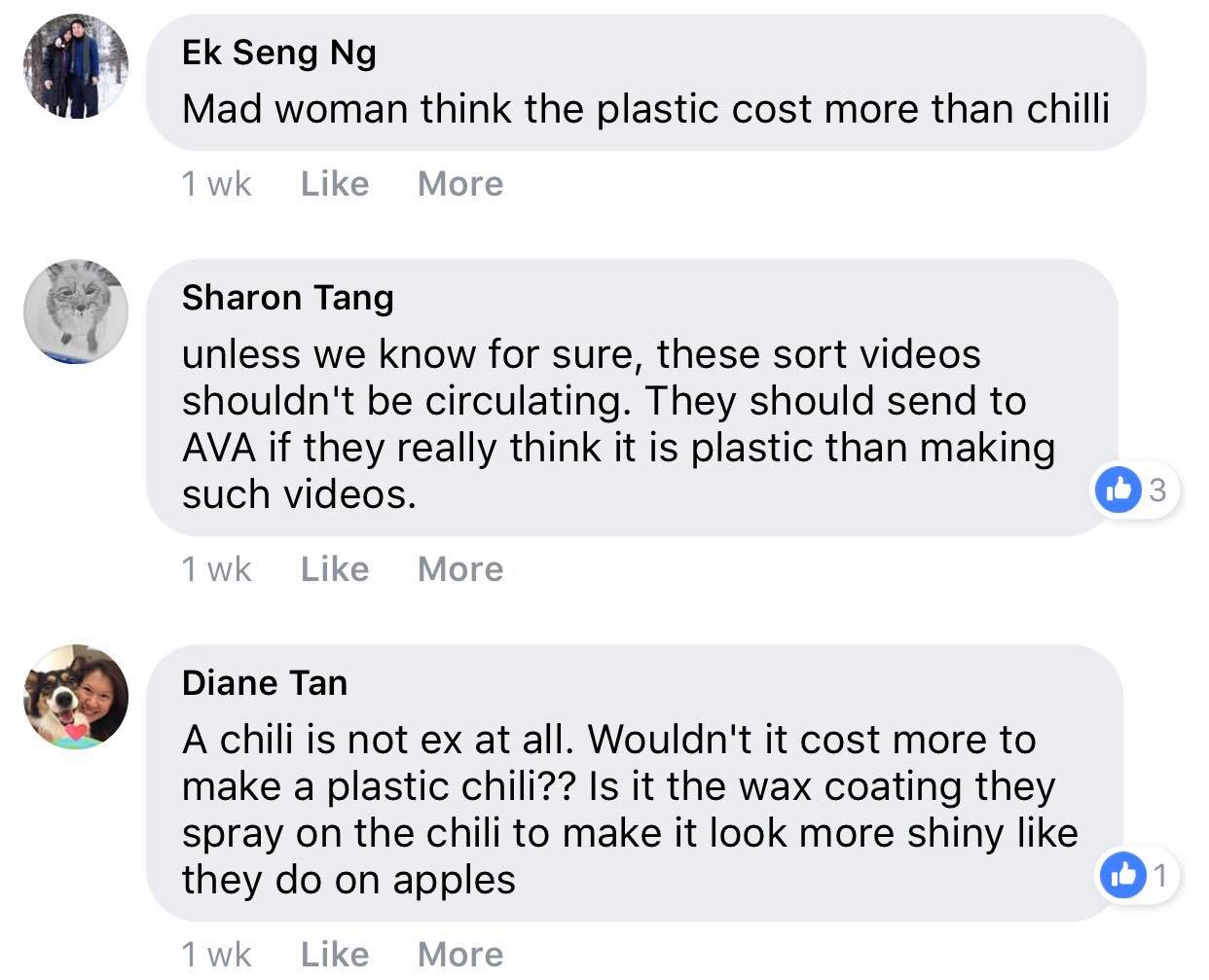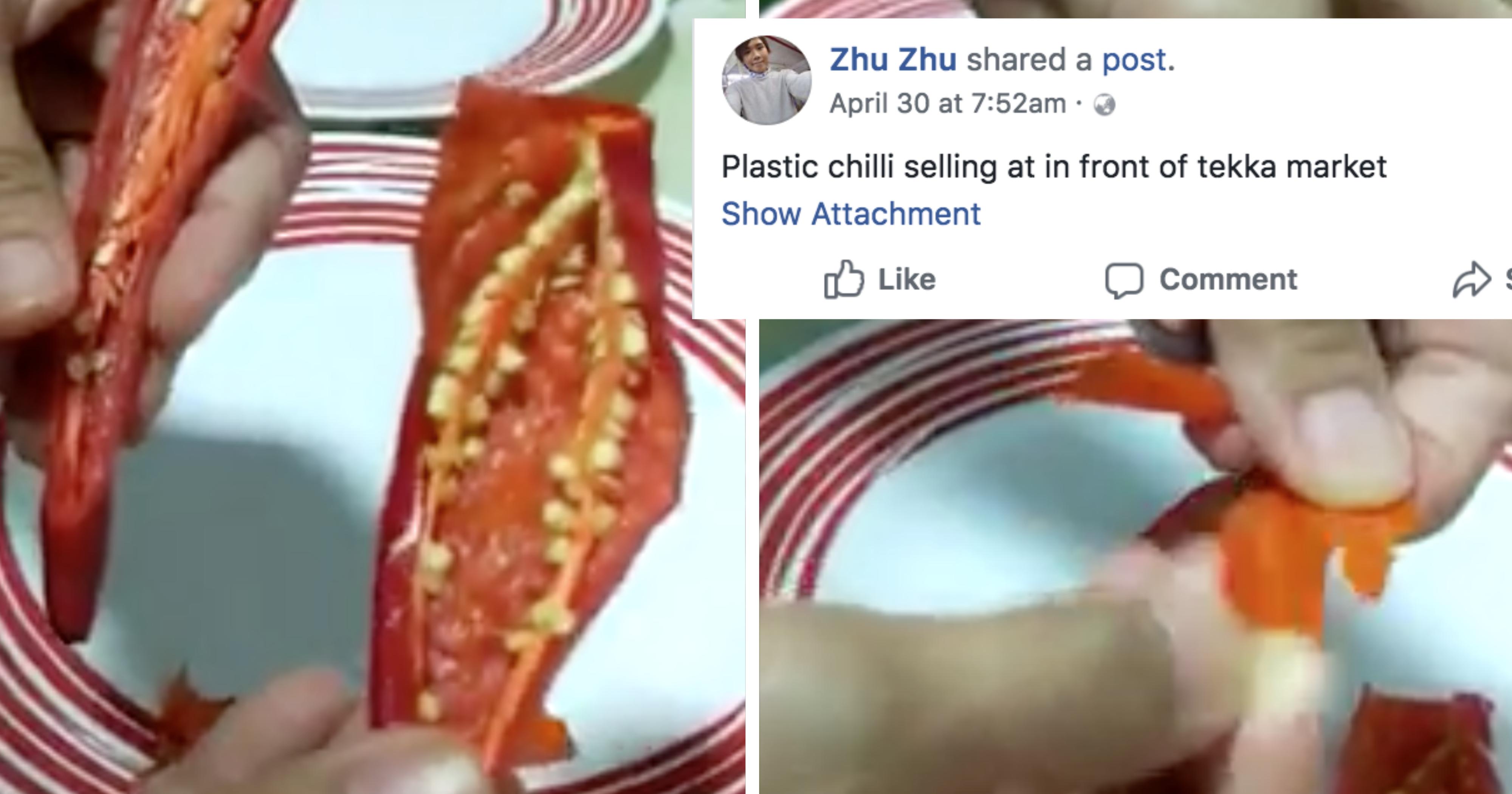A video of supposedly fake plastic chillies being sold near the Tekka market in Little India has been making rounds on Facebook since April 27, with a number of Singaporeans believing its claims.
This is the video, found in the Singapore Taxi Driver Facebook group:
At time of writing, the post has more than 1,000 shares.
In the video, a lady's voice can be heard accusing one of the chillies of being plastic.
She then picks up a shred of chilli and explains why it is fake.
In her words:
"How we know is because when we started to cook -- and make sambal belacan right -- this one is plastic you see. We grind it, but this one did not break. Plastic."
She then clarifies that it was bought in front of Tekka market, and not from the market itself.
According to the Agri-Food and Veterinary Authority, versions of this video has been circulating on Facebook since early April.
Some Singaporeans believed video
While not all who saw the video believed in its claims, most people who shared the post either did so without any clarification and repeated the message:



However, some members of the public have also pointed out that plastic chillies don't make economical sense:


Another user warned that one should not trust online sources too easily:

AVA has not detected any fake chilli
In response to Mothership.sg's queries, AVA has assured the public that they "regularly inspect and sample all food products".
So far, AVA has not detected any cases of "fake food" in Singapore.
The AVA spokesperson also said that they have previously expended time and resources investigating allegations about fake food, only to find out that they are untrue.
The grass jelly incident was one example:
Moreover, fresh produce and food products are liable to undergo changes when subjected to different conditions, such as high heat, freezing, exposure to air, and storage conditions.
While this may result in changes in taste, texture, or appearance, it does not mean that the food item is '"fake" or made with harmful materials.
Smell to check if chilli is plastic
The AVA spokesperson recommends cutting the fruit open and smelling it as a quick way to check if it's real.
Chillies have an outer protective layer known as the chilli peel, or exocarp, which is a waxy coating that helps to resist moisture loss, enhances the fruit’s firmness, and slows down the natural degradation of the chilli fruit.
[related_story]
This is AVA's statement in full:
The Agri-Food & Veterinary Authority regularly inspects and samples all food products to ensure compliance with our food safety standards and requirements. We have not detected any fake food (i.e. food made with synthetic materials) in Singapore thus far. We have previously investigated cases of alleged fake food, such as plastic rice, seaweed, grass jelly (chin chow)* and fake eggs, all of which were found to be untrue.
2. AVA investigates feedback on food safety issues and will not hesitate to take enforcement action where warranted. However, time and resources are often expended on investigating allegations about fake food, only to find out that they are untrue. We urge the public to be discerning and exercise good judgement on whether information sources are credible. The rapid spread of misinformation causes unnecessary public alarm and confusion to the public. Public should refrain from circulating unverified information.
3. Fresh produce and food products have varying properties, which may change in different circumstances (e.g. high heat or freezing, exposure to air, storage conditions etc). This may result in changes in taste, texture, or appearance, and does not mean that the food is fake or made with harmful materials, such as plastic. When in doubt, consumers are advised not to consume the food item.
Regarding the video of “fake” chili in circulation
4. AVA has not detected any fake chilli.
5. Chilli in particular has an outer protective layer known as the chilli peel (exocarp), which has a characteristic waxy look. This natural waxy coating helps to resist moisture loss, enhances the fruit’s firmness, and slows down the natural degradation of the chilli fruit. Chilli and its seeds contain the chemical capsaicin, which gives it the hot pungent taste. Chilli typically gives off a distinct smell. A quick way to check if the chilli is real is to cut the fruit open and smell it.
* For example, there were two videos circulating on “fake grass jelly” on social media platforms last year. Laboratory tests on samples collected from feedback providers found the samples to be authentic. An inspection at the manufacturing facility also found it to be satisfactorily maintained with no abnormalities in their manufacturing process. The “spongy” textures of the grass jelly in both videos may have been caused by the products going through different extents of freezing and thawing after manufacture. The process of freezing and thawing can damage the physical structure of the grass jelly. When grass jelly is frozen, the water in the jelly will turn into ice crystals and break the gelatin bonds apart. This allows the water to flow out once the jelly is thawed, causing the gelatin to clump together, and giving rise to a plastic/spongy appearance.
Top image from video
If you like what you read, follow us on Facebook, Instagram, Twitter and Telegram to get the latest updates.
